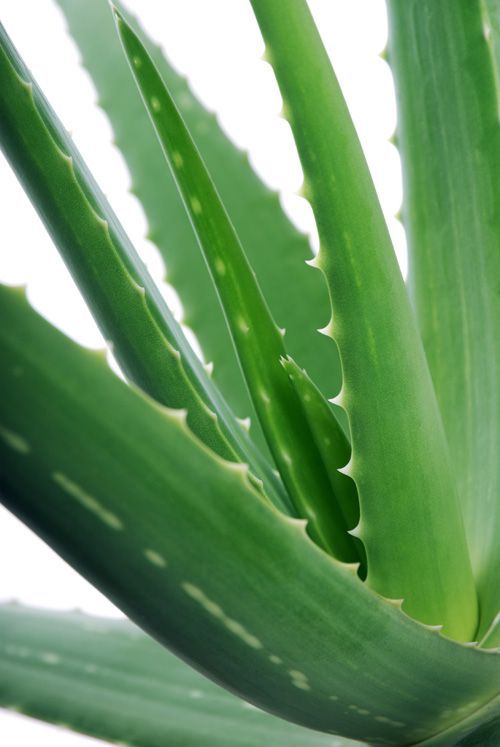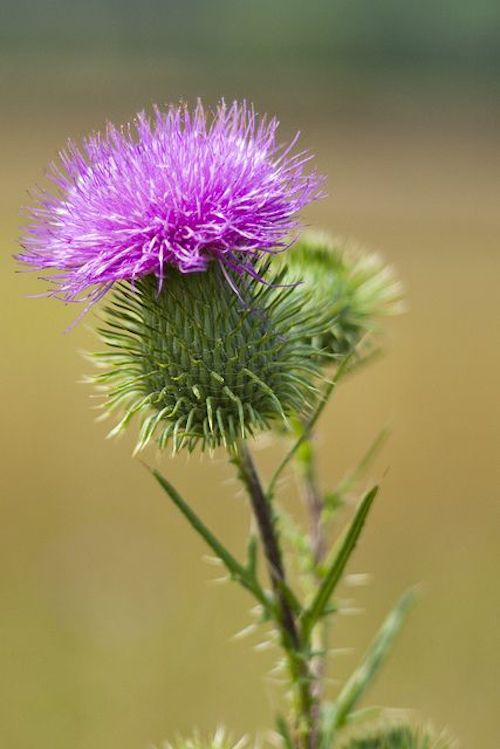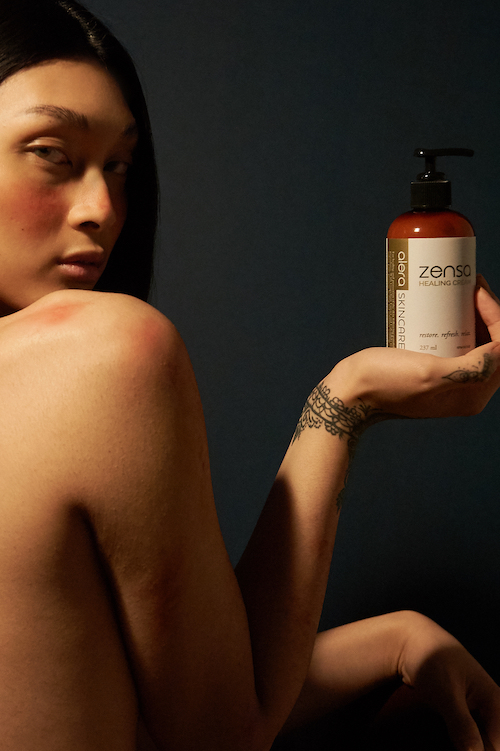10 Best Herbs For Eczema To Repair Skin Inflammation
10 Best Herbs For Eczema To Repair Skin Inflammation
When suffering from eczema, it can be challenging to feel comfortable in your own skin. Eczema (atopic dermatitis) is a chronic inflammatory skin condition that leaves your skin red, itchy and irritated. Common eczema symptoms include dry, inflamed, thick, cracked or scaly skin, itchiness, oozing or crusty skin, small raised bumps (which can leak fluid when scratched) and swollen skin (usually from scratching) and leathery skin patches (lichenification). Eczema flare-ups tend to occur intermittently. These flare-ups are caused by irritants from artificially-fragranced soaps, bath products, cosmetics and detergents to lemon, baking soda and vinegar. Lifestyle factors like stress, frequent handwashing, poor nutrition and low humidity environments (seasonal weather changes, dry air or indoor heat) can also induce flare-ups. While many children with eczema will grow out of it by the time they’re 3-4 years old, some individuals will need to manage these flare-ups throughout their teenage years and into adulthood. However, these flare-ups should become more infrequent with age. (Around 60% of people no longer show symptoms of eczema once they’re teenagers.)
Speak with your doctor or dermatologist regularly about your eczema symptoms to create an effective treatment plan. More severe cases might require prescription medication. These stronger treatment options for eczema include antibiotics, antihistamines, corticosteroids (pill, liquid or shot), phototherapy (UV ray treatment) and topical steroid creams. While there’s no cure for eczema, most cases are manageable with the right habits, skincare products and home remedies.

Read on to learn more about 10 of the best herbs to soothe inflammation and manage your eczema.
Aloe Vera
Known for its hydrating and soothing properties, aloe vera gel can calm eczema flare-ups and help manage long-term symptoms. A 2015 study found that aloe vera has clinically-significant anti-inflammatory, antimicrobial and wound-healing benefits. These benefits of aloe vera can help relieve eczema symptoms like cracked or broken skin, leaving your skin more vulnerable to infection (which can be prevented thanks to aloe vera’s antimicrobial effects). Aloe vera’s high antioxidant content repairs and improves skin barrier function. It is also a gentle and natural moisturizer, making it perfect for the sensitive and dry skin associated with eczema. Combined, these qualities of aloe vera accelerate the wound healing process while helping retain skin moisture and resilience.
Choose an aloe vera gel over an aloe vera extract. Gels have a more soothing and cooling effect on the skin and permeate the skin. Always look for products that list aloe vera gel or aloe vera juice as the primary ingredient. You can also use the pure gel from inside an aloe vera leaf directly on the skin.

Credit: Aromatic Studies/Pinterest
How To Use: First, clean and wash the skin with gentle, unscented soap and water. Apply the aloe vera directly afterward onto the skin. Use the aloe vera up to twice a day on the skin or as recommended by your doctor. If you never used aloe vera, do a small patch test on the skin to ensure that you’re not allergic.
Calendula
Calendula oil is known for its anti-inflammatory benefits, thanks to its high antioxidant content. It contains antioxidants called flavonoids and carotenoids (giving marigold flowers their vibrant hue) which address the root causes of eczema and impaired skin barrier function. Calendula oil can help alleviate skin dryness, irritation and reduce itchiness or inflammation you experience during eczema flare-ups. It has anti-fungal, anti-bacterial and power wound-healing benefits to speed up the healing process and protect the cracked skin against infection. The antioxidants in calendula oil also stimulate collagen production to repair and hydrate the damaged skin barrier caused by this chronic autoimmune condition.

Credit: @zensaskin/Instagram
Zensa Healing Cream contains medical-grade calendula oil to reduce these common eczema symptoms. Combined with medical-grade grapefruit seed oil and nourishing ingredients like aloe vera, sunflower seed oil and cucumber extract, among others, Zensa Healing Cream calms itchiness and dryness, accelerates the wound healing process and restores the skin’s moisture barrier. For best results, apply Zensa Healing Cream twice daily on freshly-cleansed skin until the symptoms resolve. Consult your doctor or dermatologist to determine whether you want to use Zensa Healing Cream as a part of your long-term treatment plan to manage your eczema symptoms.
How To Use: Calendula oil should be diluted with a carrier oil when applied topically. Some popular carrier oil options include olive oil, coconut oil, jojoba oil, grapeseed or sweet almond oil. It is generally recommended to mix the calendula oil and carrier oil with a 1:5 ratio. Calendula oil also can be found in several natural skin care creams, salves and lotions. Apply these treatments twice daily as needed.

Chamomile
Chamomile provides anti-inflammatory, antimicrobial wound-healing and skin-regenerating benefits. These crushed-up flowers are rich in antioxidants and calm common eczema symptoms like cracked skin, redness, inflammation and itchiness. Chamomile is a mild astringent, which helps soothe sensitive skin. The two most popular types of chamomile available are German Chamomile and Roman Chamomile. German Chamomile is widely considered the superior option because it offers a higher concentration of two anti-inflammatory agents (chamazulene and bisabolol, which have healing benefits for sensitive skin) – making it the preferred, more effective option of these two variations. A 2010 study found that German chamomile oil helps lower allergy markers in animals, which can contribute to or worsen eczema symptoms for certain patients. Chamomile also rehydrates the skin to restore the moisture barrier, reduce flare-ups and manage eczema symptoms (often caused by a weakened skin barrier).

Credit: Good Housekeeping/Pinterest
How To Use: Chamomile tea bags or essential oils are suitable for topical use. To create a chamomile tea bag compress, steep one tea bag in boiling water for 5 minutes. Allow it to cool to room temperature before placing it on the affected skin. Leave the tea bags on the eczema patch for 20 minutes per use. Apply up to 3 chamomile tea bag compresses daily until the flare-up resolves. To use a chamomile essential oil, dilute it with a carrier oil like olive oil, coconut oil or jojoba oil before applying it to the skin. Alternatively, you can mix 1-2 drops of chamomile essential oil into your lotion or moisturizer.
Dandelion
Dandelion plants are full of antioxidants, vitamins A, B, C and D, and minerals, including calcium, iron, magnesium and zinc. These nutrients help reduce inflammation and repair skin tissue during the wound healing process. Dandelion offers anti-inflammatory, anti-viral, antifungal and antibacterial benefits to improve common eczema symptoms and potential infections associated with a weakened skin barrier or open wounds. These flowers contain lecithin and inulin, which hydrates and draws moisture up towards the top layer of skin.

Credit: Wikipedia/Pinterest
How To Use: Dandelion can be applied topically as an essential oil or a dandelion salve. You can purchase a dandelion-infused product or make a DIY alternative at home. To make a homemade dandelion salve, first combine equal parts dried dandelion flowers with a carrier oil (like coconut, olive, jojoba or sweet almond oil) to make a DIY dandelion oil. Leave the mixture to sit for 1-2 weeks and strain out the flowers with a cheesecloth. Use this oil to make a DIY dandelion salve, and warm your freshly-made dandelion oil over a double boiler. Add beeswax to the oil. Heat the ingredients until the beeswax combines with the oil (stir occasionally). Mix in shea butter until it dissolves.
Milk Thistle
Milk thistle offers anti-inflammatory benefits and liver support to relieve eczema symptoms from the inside out. Eczema can be caused by a compromised immune system or poor liver function. Milk thistle is full of antioxidants, which help train your immune system to accelerate cellular turnover to repair and hydrate the skin barrier. The herb also contains an active compound called silymarin to support liver function. According to a 2008 study, silymarin (applied topically) helped reduce skin redness, itchiness and hydration in rosacea patients after a month of regular use. While they present differently, rosacea and eczema are both autoimmune conditions, so silymarin should be effective in treating these similar eczema symptoms.

Credit: Flickr/Pinterest
How To Use: Milk thistle can be found in topical creams and face serums. Use these products on the affected area(s) twice a day. You can also consume milk thistle supplements or teas for similar benefits. Some individuals can expect to start seeing improvement in their eczema symptoms in as little as 2-4 weeks.
Stinging Nettle
Stinging nettle provides anti-inflammatory and anti-histamine benefits to calm inflammation, redness, itchiness, skin dryness and allergic reactions that contribute to eczema flare-ups. The garden weed is rich in antioxidants to increase cellular turnover, repair the moisture barrier and aid the wound-healing process. Stinging nettle is high in vitamin C, a nutrient crucial to the skin barrier function and collagen production. Vitamin C is an antihistamine known for its role in skin health and controlling inflammation or irritating allergens. A 2018 study found that vitamin C deficiency can cause or aggravate atopic dermatitis (AD) symptoms and adequate vitamin C intake has been shown to help reduce eczema symptoms.
How To Use: Stinging nettle can be used topically (nettle cream) or taken as a supplement. Consuming stinging nettle tea has also been shown to help improve eczema symptoms. If you’re seeking a more natural remedy, try moistening nettle leaves and directly applying them to the skin.
St. John’s Wort
St. John’s Wort offers benefits to calm nearly every common eczema symptom. A 2003 study found that topical application of a cream containing St. John’s Wort twice a day for a month significantly improved the patients’ eczema flare-ups. St. John’s Wort is rich in a group of antioxidants called flavonoids, which give the flowers a vibrant yellow hue. The plant has anti-inflammatory, skin-soothing and hydrating benefits to relieve painful, red, cracked or dry, itchy skin and replenish the skin barrier. St. John’s Wort aids and accelerates the wound-healing process to heal broken skin. Its antiviral properties keep open wounds clean during the healing process to prevent infection.
How To Use: For topical use, apply St. John’s Wort oil, cleanser or cream directly onto the skin. You can also consume St. John’s Wort capsules and teas to help with underlying conditions, like depression or anxiety (stress can worsen eczema), that could trigger or aggravate flare-ups.
Sunflower Seed Oil
Sunflower seed oil is rich in vitamins A, C, D and E and linoleic acid (Vitamin F). These nutrients provide anti-inflammatory benefits and reduce skin swelling, redness, irritation and clogged pores. Linoleic acid is a building block for ceramides (the fatty acids in-between the skin cells that cushion, moisturize and protect the skin barrier). These fatty acids stimulate collagen production and increase cellular turnover to moisture and repair the damaged skin barrier (eczema is a sign of a weakened skin barrier). Linoleic acid also contains anti-microbial properties to protect open wounds and prevent infections during the healing process. Because of its restorative qualities, sunflower seed oil alleviates immediate eczema symptoms and strengthens the moisture barrier to build the skin’s resilience and help manage flare-ups over time.

How To Use: Apply pure sunflower seed oil directly onto the skin, immediately after washing it with warm water. Gently massage it into your skin. Wipe any excess away with a washcloth. Use Zensa Healing Cream to gain the benefits of sunflower seed oil alongside calendula oil, grapefruit oil, shea butter and other nourishing skincare ingredients that help relieve eczema symptoms. Apply Zensa Healing Cream on the affected areas after cleansing the skin. Use it twice a day until your symptoms clear.
Turmeric
A staple in Ayurvedic medicine, turmeric is a spice known for its bright yellow colour and healing properties. Turmeric contains curcumin, which provides anti-inflammatory, antibacterial, anti-fungal and wound-healing benefits to help treat several eczema symptoms. The spice is packed with antioxidants to soothe sensitive skin, redness, itchiness and dry, cracked skin. Turmeric can reduce inflammation and increase cellular turnover to hydrate and restore a damaged skin barrier to mitigate future eczema flare-ups. While there’s promising research on the link between topical turmeric and eczema, more studies are needed to confirm that the spice is a clinically-effective treatment option.

Credit: Haati Chai/Pinterest
How To Use: Apply a turmeric gel or ointment onto freshly-cleaned skin. Choose a turmeric-infused skin product over pure turmeric powder for topical use (the latter will not absorb properly into the skin). Turmeric supplements and teas also could potentially help manage your eczema symptoms.
Witch Hazel
Witch hazel is a mild astringent known for its anti-itch, anti-inflammatory and anti-viral benefits. Made from the tree bark of the same name, witch hazel contains antioxidants, such as gallic acid and tannins that reduce swelling, redness and irritation and soothe broken or sensitive skin. Because of its astringent properties, the herb will shrink your pores to help prevent germs or allergens from infecting the skin and worsening your eczema symptoms. Witch hazel should be used on “wet” eczema (weeping or oozing) – not dry, scaly skin.

Credit: Camille Styles/Pinterest
Weeping eczema develops from high levels of inflammation that create small, fluid-filled blisters on the skin. This condition can be caused by an infection and can lead to scarring if left untreated. Witch hazel can calm the skin, help dry up oozing eczema and hydrate the skin barrier. However, it is vital to contact a doctor if you’re concerned about your weeping eczema and see a lot of pus or experience any flu-like symptoms.
How To Use: Soak gauze in the witch hazel and apply it to the affected area. Let the “wet wrap” sit on the skin with a dry covering over the gauze. Leave the witch hazel on the eczema patch for a few hours before removing the gauze.
